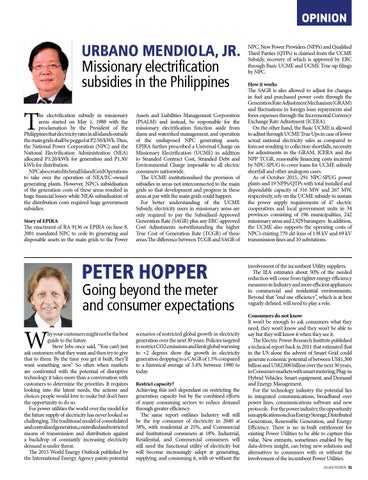OPINION
Urbano Mendiola, Jr. Missionary electrification subsidies in the Philippines
T
he electrification subsidy in missionary areas started on May 1, 1988 with the proclamation by the President of the Philippines that electricity rates in all islands outside the main grids shall be pegged at P2.50/kWh. Thus, the National Power Corporation (NPC) and the National Electrification Administration (NEA) allocated P1.20/kWh for generation and P1.30/ kWh for distribution. NPCalsocreateditsSmallIslandGridOperations to take over the operation of NEA/EC-owned generating plants. However, NPC’s subsidisation of the generation costs of these areas resulted in huge financial losses while NEA’s subsidisation of the distribution costs required huge government subsidies. Story of EPIRA The enactment of RA 9136 or EPIRA on June 8, 2001 mandated NPC to cede its generating and disposable assets in the main grids to the Power
Assets and Liabilities Management Corporation (PSALM) and instead, be responsible for the missionary electrification function aside from dams and watershed management, and operation of the undisposed NPC generating assets. EPIRA further prescribed a Universal Charge on Missionary Electrification (UCME) in addition to Stranded Contract Cost, Stranded Debt and Environmental Charge imposable to all electric consumers nationwide. The UCME institutionalised the provision of subsidies in areas not interconnected to the main grids so that development and progress in these areas at par with the main grids could happen. For better understanding of the UCME Subsidy, electricity users in missionary areas are only required to pay the Subsidised-Approved Generation Rate (SAGR) plus any ERC-approved Cost Adjustments notwithstanding the higher True Cost of Generation Rate (TCGR) of these areas.The difference between TCGR and SAGR of
PETER HOPPER
Going beyond the meter and consumer expectations
W
hy your customers might not be the best guide to the future. Steve Jobs once said, “You can’t just ask customers what they want and then try to give that to them. By the time you get it built, they’ll want something new.” So often when markets are confronted with the potential of disruptive technology it takes more than a conversation with customers to determine the priorities. It requires looking into the latent needs, the actions and choices people would love to make but don’t have the opportunity to do so. For power utilities the world over the model for the future supply of electricity has never looked so challenging. The traditional model of consolidated andcentralisedgeneration,controlledandrestricted means of transmission and distribution against a backdrop of constantly increasing electricity demand is under threat. The 2015 World Energy Outlook published by the International Energy Agency paints potential
scenarios of restricted global growth in electricity generation over the next 30 years. Policies targeted to restrict CO2 emissions and limit global warming to +2 degrees show the growth in electricity generation dropping to a CAGR of 1.5% compared to a historical average of 3.4% between 1980 to today. Restrict capacity? Achieving this isn’t dependant on restricting the generation capacity but by the combined efforts of many consuming sectors to reduce demand through greater efficiency. The same report outlines Industry will still be the top consumer of electricity in 2040 at 38%, with residential at 25%, and Commercial and Institutional consumers at 18%. Industrial, Residential, and Commercial consumers will still need the functional utility of electricity but will become increasingly adept at generating, supplying, and consuming it, with or without the
NPC, New Power Providers (NPPs) and Qualified Third Parties (QTPs) is claimed from the UCME Subsidy, recovery of which is approved by ERC through Basic UCME and UCME True-up filings by NPC. How it works The SAGR is also allowed to adjust for changes in fuel and purchased power costs through the Generation Rate Adjustment Mechanism (GRAM) and fluctuations in foreign loan repayments and forex expenses through the Incremental Currency Exchange Rate Adjustment (ICERA). On the other hand, the Basic UCME is allowed to adjust through UCME True Ups in case of lower actual national electricity sales as compared to forecast resulting to collection shortfalls, necessity for adjustments in the GRAM, ICERA and the NPP TCGR, reasonable financing costs incurred by NPC-SPUG to cover loans for UCME subsidy shortfall and other analogous cases. As of October 2015, 291 NPC-SPUG power plants and 19 NPPs/QTPs with total installed and dependable capacity of 316 MW and 267 MW, respectively, rely on the UCME subsidy to sustain the power supply requirements of 47 electric cooperatives and local government units in 34 provinces consisting of 196 municipalities, 242 missionary areas and 2,929 barangays. In addition, the UCME also supports the operating costs of NPC’s existing 770 ckt-kms of 138 kV and 69 kV transmission lines and 10 substations.
involvement of the incumbent Utility suppliers. The IEA estimates about 50% of the needed reduction will come from tighter energy efficiency measures in Industry and more efficient appliances in commercial and residential environments. Beyond that “end use efficiency”, which is at best vaguely defined, will need to play a role. Consumers do not know It won’t be enough to ask consumers what they need, they won’t know and they won’t be able to say but they will know it when they see it. The Electric Power Research Institute published a technical report back in 2011 that estimated that in the US alone the advent of Smart Grid could generate economic potential of between US$1,300 billion and US$2,000 billion over the next 30 years, in Consumer markets with smart metering, Plug-in Hybrid Vehicles, Smart equipment, and Demand and Energy Management. For the technology industry the potential lies in integrated communications, broadband over power lines, communications software and new protocols . For the power industry, the opportunity isinapplicationssuchasEnergyStorage,Distributed Generation, Renewable Generation, and Energy Efficiency. There is no in-built entitlement for existing Power Utilities to be able to capture this value. New entrants, sometimes enabled by big data-driven insight, can bring new solutions and alternatives to consumers with or without the involvement of the incumbent Power Utilities. ASIAN POWER 31
